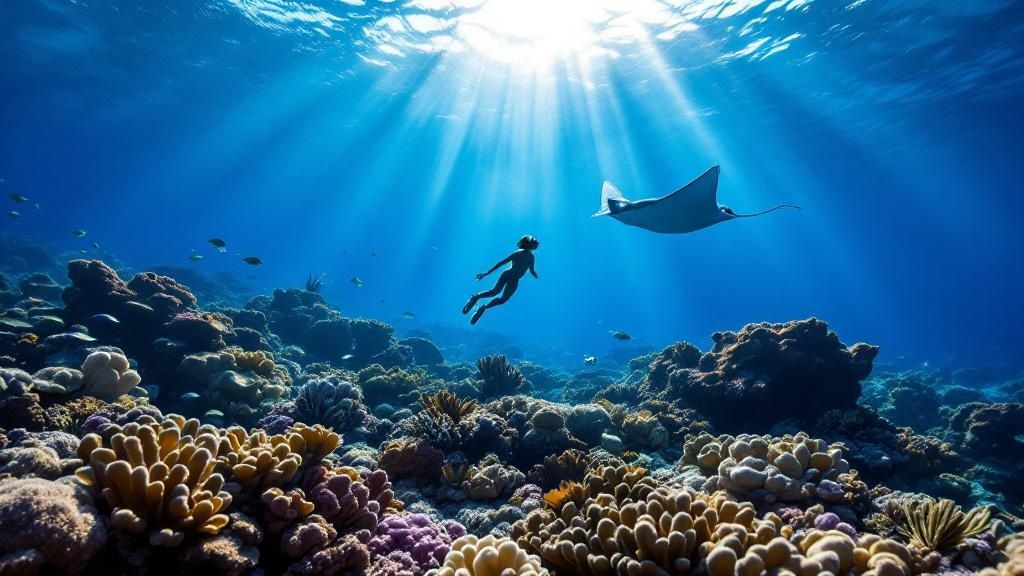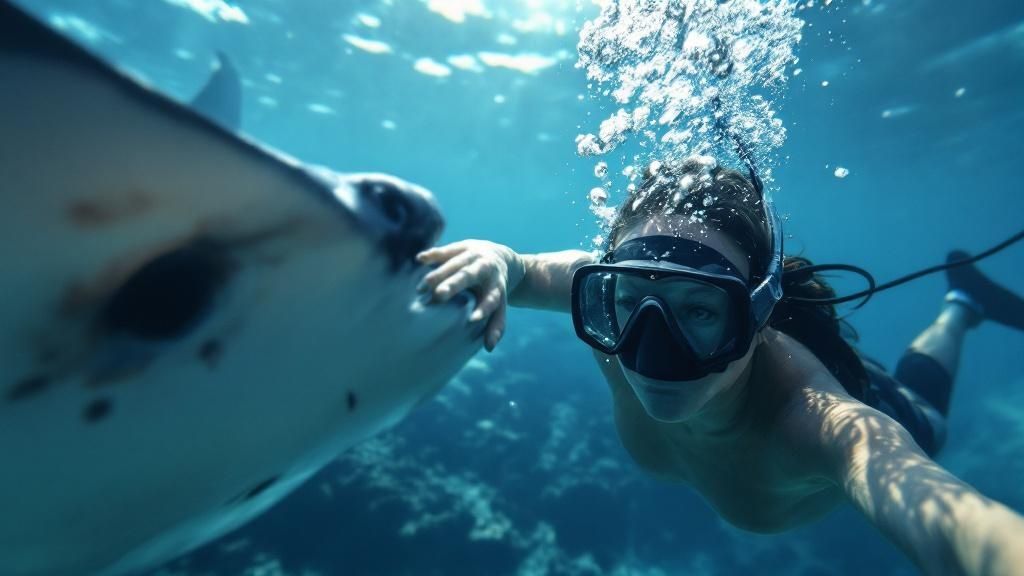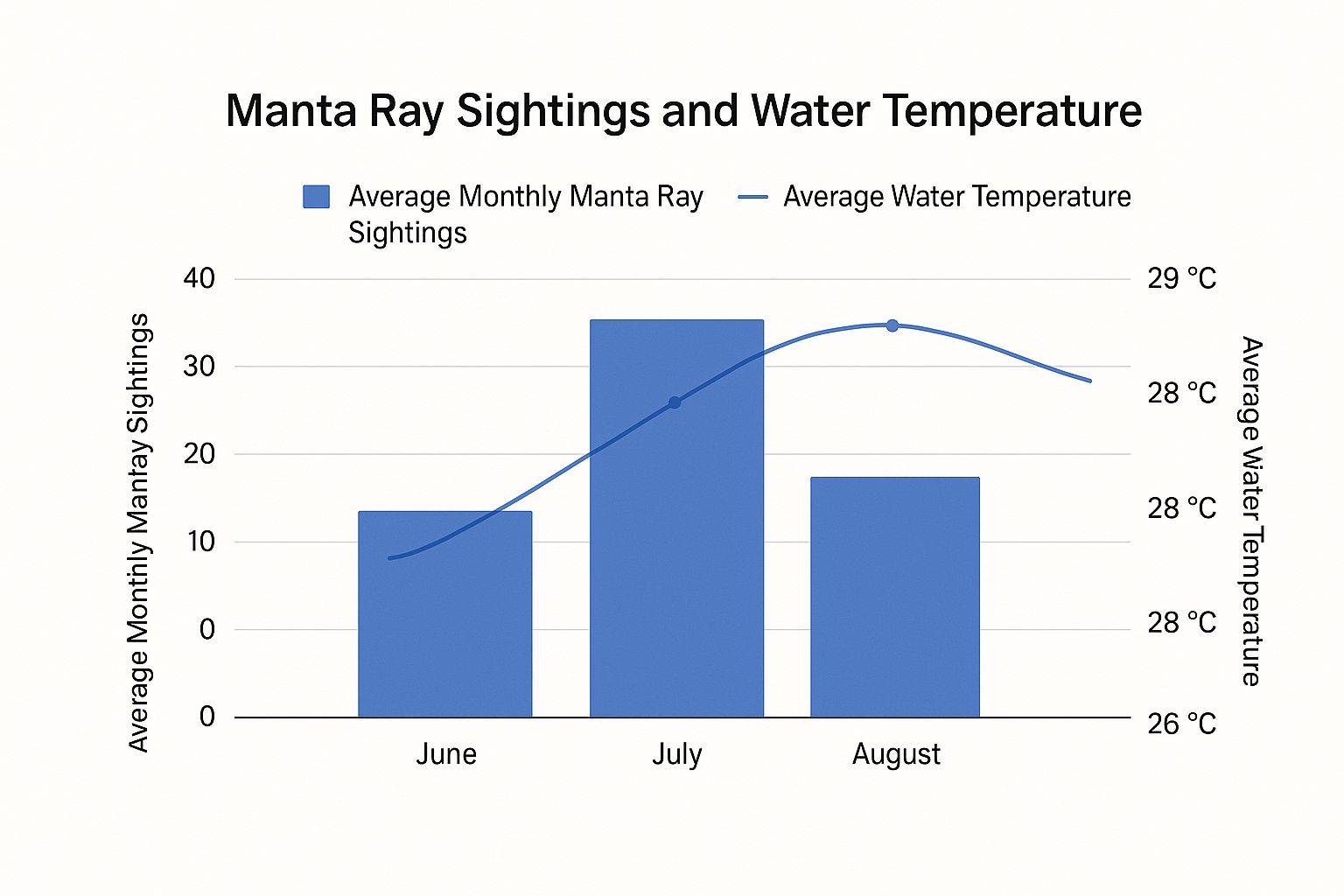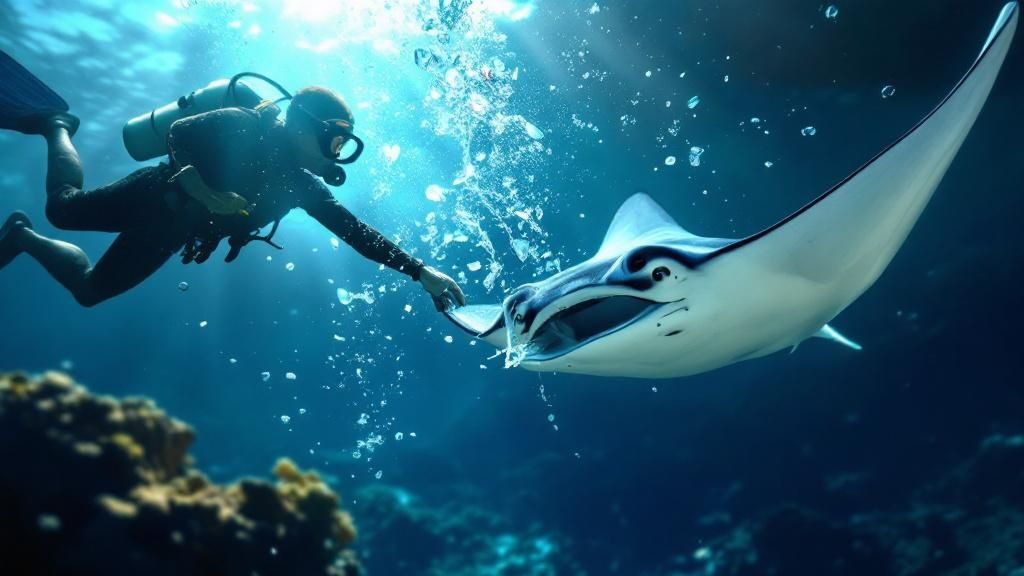Manta Ray Snorkel Kona: Ultimate Hawaii Marine Adventure
- Byron
- May 29
- 12 min read
Why Kona Stands Above All Other Manta Ray Destinations
Kona, Hawaii, isn't just another tropical getaway; it's the manta ray capital of the world. This isn't by chance. A unique combination of volcanic geology, nutrient-rich waters, and dedicated conservation efforts creates a perfect haven for these gentle giants.
The Perfect Habitat: A Fusion of Volcanoes and Plankton
The volcanic formations off the Kona coast create an intricate underwater landscape. These lava formations act as natural plankton traps, providing a feast for manta rays, whose diet primarily consists of these tiny organisms. Kona's nutrient-rich currents further enhance this plankton buffet, creating blooms that attract manta rays to specific feeding grounds. Locations like Manta Village and Manta Heaven are famous for these plankton-rich waters, acting like magnets for these graceful creatures.
Reliable Encounters: Kona's Unmatched Success Rate
This abundance of plankton combined with sheltered bays and coves results in incredible manta ray viewing opportunities. Kona boasts an impressive 80-90% success rate for manta ray sightings on organized tours. This remarkable consistency draws approximately 80,000 people annually to experience manta ray snorkel tours. This has solidified Kona's reputation as a global hotspot for this unique marine encounter. Manta Ray Snorkel Kona Statistics offer further insight into these impressive numbers.
Conservation: A Thriving Ecosystem for Mantas and Tourism
Kona's success is also deeply intertwined with committed conservation work. Local groups and tour operators actively protect the manta rays and their habitat. Strict guidelines are in place to minimize disturbances to the animals, and sustainable tourism practices ensure the long-term well-being of the ecosystem. This dedication to responsible wildlife tourism benefits both the manta rays and the local economy. When you choose a manta ray snorkel tour in Kona, you're not just observing an amazing natural wonder; you're also supporting sustainable marine tourism. Learn more about planning your experience: The Ultimate Experience Guide.
Your Complete Manta Ray Snorkel Experience Guide

From the initial safety briefing to that first glimpse of a manta ray gliding beneath you, a manta ray snorkel in Kona, Hawaii is an unforgettable experience. This guide walks you through each step, so you know what to expect from this amazing adventure.
Preparing For Your Nighttime Encounter
Your adventure begins with a pre-trip briefing. Tour operators will explain how underwater lights attract plankton, which in turn creates a feeding frenzy that draws the manta rays to the surface. This method leads to consistent sightings, with Kona boasting an impressive 80-90% success rate. It's no wonder that approximately 80,000 people participate in these tours every year.
The Snorkeling Experience: Up Close and Personal
Once on the water, you'll be guided to a designated viewing area. Many operators use a large illuminated board for snorkelers to hold onto. This creates a stable platform, allowing you to comfortably observe the manta rays as they feed just below. You’ll be amazed by their graceful movements and impressive size, with wingspans often reaching 5-10 feet. Some individuals, like the famous "Big Bertha," can even reach an astounding 14 feet!
Accessibility and Safety For All
Manta ray snorkeling is surprisingly accessible to people of all skill levels. Comprehensive safety protocols and expert guidance ensure everyone feels comfortable, even those who aren't strong swimmers. Flotation devices are often provided for additional support. Guides are attentive to individual needs, prioritizing both participant safety and respect for the manta rays. This carefully managed activity ensures a positive experience for all. For more detailed information, check out this guide: How to Master Your Manta Ray Snorkel Adventure.
Addressing Concerns About Night Snorkeling
Many people have understandable apprehensions about swimming at night. However, the presence of experienced guides, safety lights, and the practice of staying within a designated area helps alleviate these fears. The experience itself is so captivating that any initial nervousness quickly transforms into awe and wonder. It’s a truly special way to observe these gentle giants in their natural environment.
Respecting the Gentle Giants: Tips For Interaction
While you'll want to maximize your viewing time, it's vital to respect these magnificent creatures. Avoid touching the manta rays, as their mucous layer is essential for their health. Remain calm and avoid sudden movements, allowing them to feed undisturbed. By following these simple guidelines, you'll contribute to a sustainable and enriching experience for both yourself and the manta rays.
Manta Ray Science And Conservation Breakthroughs

Kona, Hawaii, isn't just a fantastic spot for manta ray snorkel tours; it's a hub for cutting-edge manta ray research. The area's unique environment and the consistent presence of manta rays give scientists an incredible opportunity to study these often elusive animals. What's even better? Your manta ray snorkel adventure in Kona directly supports their ongoing conservation.
Unlocking the Secrets of Manta Ray Behavior
Researchers in Kona are using advanced techniques to learn more about manta ray behavior, migration patterns, and social structures. One major advancement is the development of an individual identification system.
This system relies on the unique spot patterns found on each manta ray's underside, much like a human fingerprint. This allows scientists to track individual manta rays over long periods, some even exceeding ten years!
Since the mid-2000s, researchers have been meticulously tracking manta ray sightings. Organizations like Manta Ray Advocates Hawaii provide yearly statistics from 2009 onward, offering valuable historical data. You can explore these detailed statistics here: Manta Ray Statistics. This long-term tracking provides invaluable insights into individual life histories, population dynamics, and the overall health of the manta ray population.
Tourism's Impact on Conservation
When you participate in a manta ray snorkel tour in Kona, you're directly contributing to this vital research. Many tour operators donate a portion of their profits to conservation efforts.
These programs focus on important areas such as:
Habitat protection: Safeguarding vital feeding grounds and cleaning stations crucial for manta ray survival.
Research initiatives: Funding scientific studies that expand our understanding of manta ray biology and behavior.
Education and outreach: Raising public awareness about the importance of manta ray conservation and promoting responsible tourism.
Innovative Research Approaches
Scientists are always seeking new and innovative ways to study manta rays in Kona. Some of these exciting approaches include:
Acoustic tagging: Using small tags that emit unique sounds, allowing researchers to follow manta ray movements across vast distances.
Aerial surveys: Employing drones and aircraft to survey manta ray populations and observe their behavior from above.
Genetic analysis: Examining manta ray DNA to better understand their genetic diversity and evolutionary history.
These advanced research methods are uncovering fascinating details about manta ray feeding habits, reproductive cycles, and the effects of environmental changes. By choosing to snorkel with manta rays in Kona, you're actively participating in a larger movement to protect these magnificent creatures for future generations.
Finding Your Perfect Kona Manta Ray Tour
So, you're dreaming of a magical manta ray snorkel experience in Kona? You've come to the right place! Finding the perfect tour involves a few key considerations, from budget and group size to the specific snorkeling site and tour operator. Let's dive in and explore how to choose the best tour for an unforgettable encounter. For more information, check out our guide on Manta Ray Snorkeling Kona.
Understanding Tour Options
Kona offers a diverse range of manta ray tours, each with its own unique characteristics. Understanding these differences will help you narrow down your choices.
Group Size: Do you prefer a more intimate setting? Small-group tours provide personalized attention from the guides. If you enjoy a lively atmosphere and are traveling on a budget, a larger group tour might be the better option.
Departure Locations: Kona has several launch points for manta ray tours. Consider the proximity of the departure location to your accommodation to minimize travel time.
Boat Size: Larger boats offer greater stability on the water, while smaller, more nimble boats can often access viewing areas more quickly.
Amenities: Some tours offer extras like underwater photography packages, refreshments, and wetsuit rentals. Think about which amenities are important to you and factor them into your decision.
Choosing the Right Snorkeling Site
Kona boasts several renowned manta ray snorkeling sites, each with its own distinct features. Manta Village, known for its calm and shallow waters, is an excellent choice for beginners. For a more challenging experience, Manta Heaven, with its deeper waters, can offer truly rewarding encounters.
The infographic below provides a visual overview of average manta ray sightings and water temperatures from June through August.

As you can see, July often boasts the highest number of manta ray sightings combined with comfortable water temperatures, making it a popular month for this activity.
Evaluating Tour Operators
Choosing a reputable tour operator is crucial for a positive and safe experience. Look for operators committed to sustainable tourism practices and respectful wildlife interactions. Reading online reviews can provide valuable insights into the quality of the guides, equipment, and the overall experience offered by different operators. Some operators offer a "manta guarantee," providing a free repeat tour if you don't see any manta rays on your first trip.
To help you compare different Kona Manta Ray Tour options, take a look at the table below:
Kona Manta Ray Tour Comparison
Tour Type | Group Size | Duration | Key Features | Best For |
|---|---|---|---|---|
Small Group Sunset Tour | 6-12 | 2-3 hours | Personalized attention, experienced guides, complimentary photos | Those seeking a more intimate experience |
Large Group Sunset Tour | 20-40 | 2-3 hours | Budget-friendly, lively atmosphere, onboard entertainment | Budget travelers and larger groups |
Private Charter | Customizable | Customizable | Exclusive access, tailored itinerary, premium amenities | Families, special occasions, and those seeking ultimate privacy |
This table summarizes the key differences between various tour types, allowing you to quickly identify the best option based on your preferences and needs. Remember to research specific operators and their offerings before booking.
Timing and Booking Strategies
Finally, consider these timing and booking strategies to secure your spot and maximize your chances of an amazing manta ray encounter:
Peak Season vs. Optimal Conditions: Summer (June-August) typically offers calmer waters and higher sighting probabilities but coincides with higher tourist traffic.
Moon Phases: Reduced moonlight enhances plankton visibility, attracting more manta rays to the surface for feeding, making these nights ideal for viewing.
Booking in Advance: Especially during peak season, booking your tour at least two weeks in advance is highly recommended to guarantee your spot.
For more guidance on timing your trip, check out: Best Time To See Manta Rays in Kona: Your Ultimate Guide. By carefully considering these factors, you’ll be well on your way to an incredible manta ray snorkeling experience in Kona.
Essential Preparation For Your Underwater Adventure

Getting ready for your manta ray snorkel Kona adventure is about turning excitement into confidence. Knowing what gear to bring, what to wear, and how to mentally prepare can significantly improve this unique experience.
Gear Up: Essentials for Your Manta Ray Snorkel Kona Trip
Kona's waters are typically warm, but preparing for different conditions makes your manta ray snorkel more enjoyable. Here are a few must-have items:
Wetsuit: A wetsuit is crucial for warmth, especially at night when the water cools down. A 3mm wetsuit usually works in summer, while a 5mm wetsuit provides better protection in winter. Don't forget water shoes for safe and easy movement on the boat and in the water.
Underwater Camera: Capture the magic with an underwater camera. GoPro or similar waterproof cameras with good low-light performance are perfect for filming the manta rays. Be sure to test your camera beforehand.
Towel and Dry Clothes: After your snorkel, there's nothing like changing into dry clothes. Pack a towel and a fresh outfit for post-snorkel comfort.
Seasickness Remedies: If you're prone to seasickness, taking precautions is a good idea. Dramamine or motion sickness patches can help. Opting for a larger, more stable boat can also make the ride smoother.
Respecting the Rays: Essential Etiquette for Your Manta Ray Snorkel
Manta rays are gentle giants. Understanding proper etiquette is essential for your safety and theirs. These guidelines ensure a respectful and sustainable interaction:
Maintain a Safe Distance: Never touch a manta ray. Their protective mucous layer is vital for their health, and touching can disrupt it. Observe them from a respectful distance.
No Flash Photography: Avoid using flash photography. It can disorient and stress the manta rays, affecting their natural behavior. Rely on the tour operators' lights or natural light.
Listen to Your Guide: Your guides are experts on manta ray behavior and safety. Following their instructions ensures a safe and informative experience for all.
Control Your Movements: Sudden movements and splashing can disturb the manta rays. Move slowly and calmly in the water.
Mental Preparation: Conquering Concerns About Night Snorkeling
If you're new to night snorkeling, feeling a little anxious is completely normal. Here's how to ease your mind:
Communicate With Your Guide: Talk to your guide about any concerns you have about night swimming or the open ocean. They can offer reassurance, support, and alternative viewing options from the boat.
Focus on Your Breathing: Deep, slow breaths are incredibly effective for managing anxiety, both before and during your snorkel. This promotes relaxation and calmness.
Think Positive: Remember, many people enjoy manta ray night snorkels in Kona every year. Focus on the amazing opportunity to see these magnificent creatures.
By following these preparation tips, you'll be ready for your manta ray snorkel Kona experience, ensuring a truly unforgettable adventure.
Timing Your Visit For Optimal Manta Ray Encounters
Perfecting the timing of your visit is crucial for an unforgettable manta ray snorkel experience in Kona. Several factors influence both manta ray behavior and tour availability. Understanding these nuances will significantly enhance your trip planning. Everything from seasonal changes and environmental factors to the phases of the moon can impact your experience. For a comprehensive guide, check out this helpful resource: Best Time To See Manta Rays in Kona: Your Ultimate Guide.
Seasonal Patterns and Manta Ray Behavior
Manta rays grace the waters of Kona year-round. However, certain periods offer more predictable and favorable viewing conditions. The dry season, spanning from April to October, typically boasts calmer waters and enhanced visibility. This makes for a more pleasant snorkeling experience, especially for those new to snorkeling. The summer months, June through August, are especially popular due to exceptional visibility. Keep in mind, this also coincides with peak tourist season, so booking your tour well in advance is highly recommended.
Navigating Winter Conditions and Backup Strategies
The winter months, from November to March, can bring increased winds and rougher seas, sometimes resulting in tour cancellations. While the manta rays are still present, accessing them becomes more challenging. Experienced tour operators often have backup plans in place. These might include relocating to sheltered bays or rescheduling for a different day. Choosing a reputable tour provider with this kind of flexibility is a significant advantage.
Understanding the Influence of Moon Phases and Ocean States
The moon surprisingly plays a role in optimal manta ray viewing. Darker nights, with reduced moonlight, actually improve the visibility of plankton. This attracts more manta rays to the surface to feed, making these nights ideal for observing these graceful creatures. Ocean currents and tides also influence plankton concentration, further impacting manta ray behavior.
Practical Advice For Flexible Booking and Ideal Conditions
Here are a few tips to maximize your chances of encountering ideal conditions:
Book in advance: Advance booking is particularly crucial during the peak summer months. Many operators suggest booking at least two weeks prior to your desired tour date.
Consider shoulder seasons: The months of April-May and September-October offer a sweet spot with pleasant weather and fewer crowds.
Be flexible: If your schedule allows, build in some flexibility. This enables you to reschedule if weather conditions are less than ideal on your initial chosen date.
Choose reputable operators: Experienced operators possess in-depth knowledge of local conditions and have contingency plans for challenging weather.
By considering these factors and maintaining a flexible approach, you'll be well-prepared for an incredible manta ray snorkel adventure in Kona.
The Future Of Sustainable Manta Ray Tourism
Kona's approach to manta ray tourism has become a global model, showcasing how responsible wildlife tourism can benefit both the local economy and the environment. This careful balance helps ensure the manta ray population thrives while providing income and jobs for the local community.
Economic Benefits and Conservation Funding
The manta ray tourism industry in Kona generates significant revenue that directly supports vital research and conservation work. Many tour operators donate a portion of their profits to organizations focused on manta ray protection and research. This funding supports important initiatives like habitat preservation and the development of sustainable tourism practices. The industry also creates jobs for local residents, further strengthening the economic impact of this model.
The importance of manta ray snorkeling in Kona, both economically and ecologically, is highlighted by its international reputation and sustainable approach. With 80,000 annual participants in recent years, the local industry generates substantial revenue while promoting environmental responsibility. Learn more: Manta Ray Report. For more information on Kona manta ray snorkeling, check out: Manta Ray Snorkel Kona: Hawaii's Best Underwater Experience.
Sustainable Practices For a Thriving Ecosystem
Strict guidelines for interaction and habitat protection are key to Kona's sustainable approach. These measures protect the manta rays while still allowing visitors to experience these gentle giants in their natural environment. For instance, guidelines prohibit touching the manta rays and restrict flash photography to minimize disruption. This ensures tourism grows alongside the manta ray population, not at its expense.
Kona's Global Influence and Long-Term Vision
Kona's success is influencing marine tourism practices worldwide. The model provides a framework for other destinations looking to balance economic growth and environmental protection. The long-term vision for manta ray tourism in Kona focuses on continued collaboration between tour operators, researchers, and conservationists. This partnership will help ensure future generations can also witness these magnificent creatures in a healthy, protected ecosystem. Taking a manta ray snorkel tour in Kona directly contributes to this conservation success story, extending its positive impact beyond your personal adventure.
Book your unforgettable Manta Ray Night Snorkel Kona Hawaii Tour today! Click here to reserve your spot and experience the magic of these gentle giants firsthand.
Comments